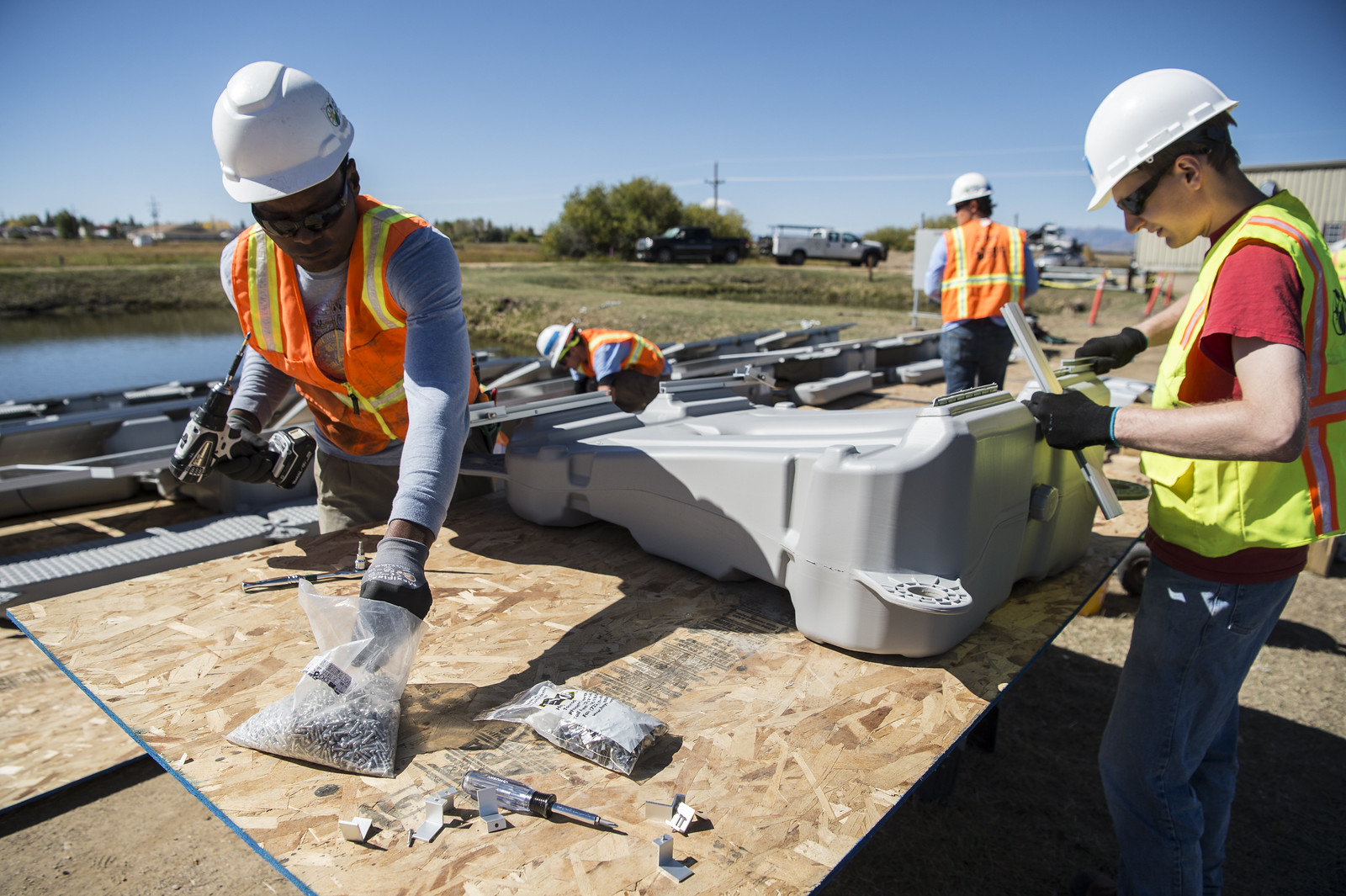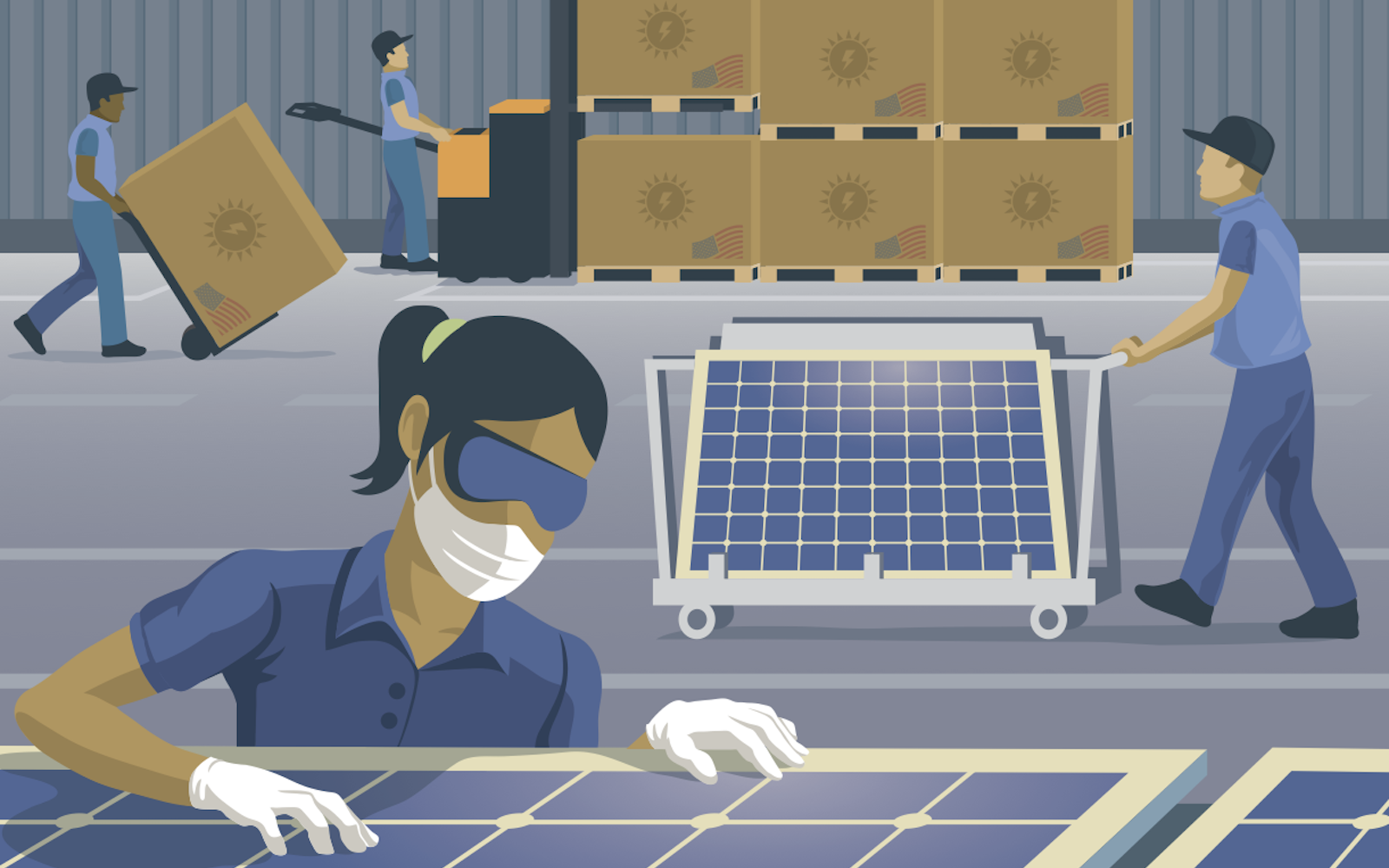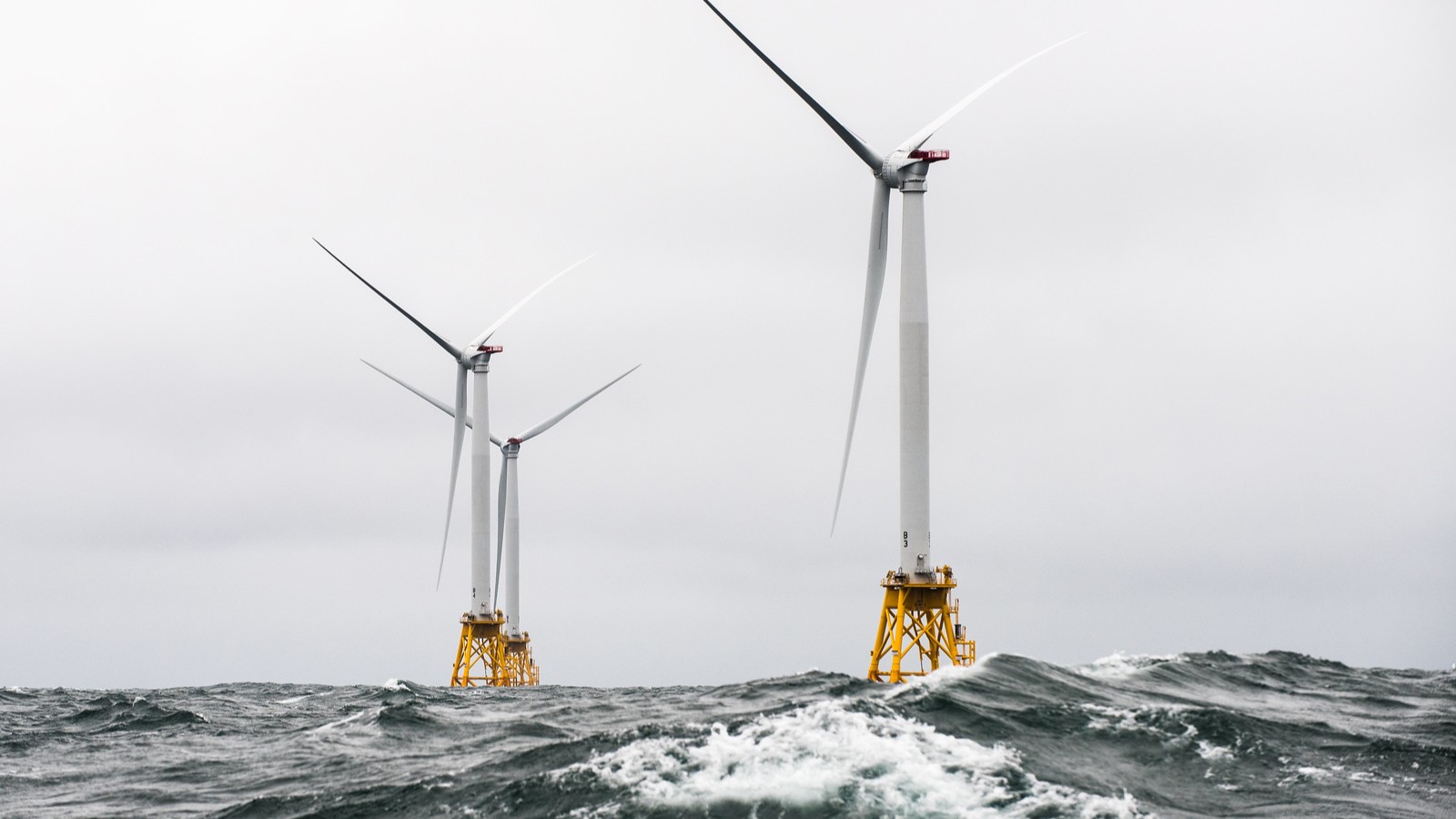The grid is undergoing a rapid transformation. American households and businesses are electrifying everything from vehicles to heating and cooling systems on the path to deep decarbonization. This widespread electrification is expected to more than double overall electricity demand by 2050 and dramatically change the magnitude and timing of peak demand in the coming decades. Recent utility forecasts predict dramatic rises in peak demand from the resurgence in American manufacturing and data centers spurred by artificial intelligence. Utilities could use this as an excuse to double down on fossil gas, which would be a climate and pollution disaster.
Instead of building new fossil gas plants that will pollute communities and harm the climate for decades, we can meet rising electricity demand with virtual power plants (VPPs) that enable a more clean, efficient, and flexible grid—and at a much lower cost. National and state climate targets are steering the U.S. toward 100 percent carbon-free electricity, backed up by the historic clean energy investments of the Inflation Reduction Act, Infrastructure Investment and Jobs Act, and CHIPS and Science Act. Renewable energy is cheaper than ever, and capacity is expected to triple by 2035 to meet rising demand and decarbonize the grid. Electrification and renewable energy combined can create millions of jobs and cut 70–80 percent of U.S. carbon pollution—but only if they work in concert to protect grid reliability and serve load.
That is where demand flexibility comes in. The existing grid is designed to meet demand peaks that occur only a few hours a year with additional power lines and power plants sitting around unused much of the year—including expensive fossil gas plants that only fire up during peak times (referred to as “peaker plants”). By reshaping and lowering peak load, demand flexibility makes the grid more efficient and reliable. By avoiding the use of dirty peaker plants, flexibility lowers emissions and improves air quality in frontline communities. Lowering peak demand also protects customers with high energy burdens from the increased electricity bills that would be needed to fund new, unneeded power plants and grid infrastructure.
Virtual power plants are key to achieving demand flexibility. VPPs are distributed energy resources (DERs), aggregated and orchestrated at scale, that provide grid services. As record amounts of variable renewable energy capacity are deployed this decade, VPPs can strategically adjust demand, making it easier to maintain grid reliability. The DERs in a VPP can be numerous and varied, from smart thermostats to EV chargers and solar plus battery storage. VPP participants can be residential customers or commercial and industrial customers, and they can own or lease their DER assets. Every type of VPP offers flexibility: They can shift or reduce demand and, in some cases, export energy back to the grid.
According to the Department of Energy, tripling VPP capacity this decade could address 10–20 percent of peak demand and save over $10 billion in annual grid costs by 2030. With the right standards and incentives in place, VPPs can also earn people money by providing demand flexibility, for example, through managed EV charging or home battery storage. Tripling VPP capacity will also require investment in workforce training and development to ensure enough qualified electricians and contractors with family-sustaining wages are available to install and repair DERs. This means that demand flexibility policy is an enormous near-term climate opportunity, with the potential to drive equitable electrification and job creation across the transportation and building sectors.
States are the primary actors that can unlock demand flexibility and the reduced pollution, cost savings, and enhanced grid reliability that they bring. In Maryland, the recently passed Distributed Renewable Integration and Vehicle Electrification (DRIVE) Act is one positive example more states can follow.
Five Policy Solutions to Unlock VPPs and Build a Flexible Grid
1. Pass planning and procurement requirements for utilities
Without adequate grid planning and investment, widespread electrification could create serious reliability and resource adequacy problems for utilities. Public utility commissions (PUCs) and state legislatures can address this by requiring utilities to consider VPPs as cost-effective, non-wires alternatives in their distribution system, transmission expansion, and integrated resource planning. States can also direct utilities to weave these planning processes with integrated distribution system planning. While DERs already show up in most utility planning, most utilities have room to update and improve their processes. To hasten these improvements, regulators can set requirements to explicitly align planning with state climate, equity, and energy efficiency targets and direct utilities to consider the full value of VPPs, including emissions reductions, local air quality improvements, reduced demand, and avoided or deferred grid investments. A 2023 report from The Brattle Group quantifying societal benefits from VPPs is one potential starting point for improving cost-benefit assessments. State energy offices and PUCs can also turn to the Department of Energy and Lawrence Berkeley National Lab for best practices and technical assistance to support integrated grid planning.
Beyond planning, state laws can also mandate procurement targets for utilities to meet a certain percentage of resource adequacy needs with demand flexibility. In Oregon, Portland General Electric has set its own goal to meet 25 percent of peak demand with DERs by 2030. Legislators in other states could pass similar targets into law. For example, a bill introduced in the California State Senate would require all load-serving entities to procure capacity from VPPs.
Demand flexibility procurement can layer on top of legally binding energy efficiency standards, as in Hawaii, and renewable portfolio standards that include carve-outs and credit multipliers for DERs. Many states have already enhanced grid planning and passed strong clean energy targets; every state should follow suit or revisit existing policies to ensure that utilities are prepared to integrate and invest in VPPs that will serve a cleaner grid.
2. Pair DER incentive programs with easy or automatic VPP enrollment
DERs can only provide demand flexibility at scale if they are deployed and managed at scale. To accelerate deployment, states should take advantage of federal grants, Title 17 loans, and clean energy tax credits with direct pay. States should stack their own rebates and inclusive financing programs on top of these funds to make EVs, chargers, solar and battery storage, and electric appliances more affordable. States across the country already offer electrification rebates, from California to Massachusetts, that other states can look to as examples. The best incentive programs are issued at the point of sale, prioritize underserved communities, and come with no-cost home energy assessments. In Illinois, utilities are also required to adopt inclusive financing programs that make energy upgrades accessible to anyone who pays an energy bill, regardless of income or credit score.
By themselves, federal and state incentives are insufficient to unlock demand flexibility at scale. Customers save money through rebates on EVs and electric appliances, but unmanaged, those technologies add to overall electricity demand without necessarily providing grid services. To address this gap, states should make DER incentives go hand-in-hand with enrollment in VPPs or load reduction incentive programs. As a first step, state agencies and utilities should pursue creative, equitable engagement strategies to increase VPP participation and help customers easily pair electrification rebates with VPP enrollment.
State and utility incentive programs should also make VPP or demand response program enrollment default for customers who install rebate-eligible DERs or consider tying rebate eligibility to automatic enrollment. In the private sector, Google has partnered with over 110 utilities to help ratepayers simultaneously find a rebate and enroll in its Rush Hour Rewards program for Nest smart thermostats. Certain managed EV charging programs, including Portland General Electric’s Level 2 Smart Charging Program in Oregon and Consumers Energy’s PowerMIDrive in Michigan, already come with rebates for purchase and installation. State legislators or PUCs could direct utilities to similarly pair rebates with demand response or managed charging incentive programs for EV chargers, battery storage, and smart thermostats and make enrollment default.
3. Reward individuals and VPP aggregators for demand flexibility through load reduction incentive programs
In 2020, the Federal Energy Regulatory Commission (FERC) issued Order 2222, which directed grid operators to allow VPPs to participate in wholesale electricity markets. To this day, Order 2222 implementation is slow and uneven across regions, excluding VPPs from a major potential revenue stream. To create additional value for VPPs and make demand flexibility more affordable, state energy offices and utilities should administer their own load reduction incentive programs. These programs benefit the grid, reducing the risk of power outages and lowering peak prices by dispatching load reduction during times of particularly high grid stress or electricity prices. In return for providing grid services, enrolled participants get paid, and VPP aggregators can share earnings between the company and its customers.
States should design load reduction incentive programs to be inclusive and equitable. Programs should allow co-participation in net metering and wholesale electricity markets as enabled by FERC Order 2222 to avoid shutting out VPP aggregators. To advance equitable VPP deployment, residential customers and commercial facilities in low-income and high-energy-burden communities should receive additional incentives. Both individual customers and VPP aggregators should be allowed to sign up and earn money without restrictive size and location requirements.
Existing programs and resources exist to help states design their own incentives. Massachusetts’ ConnectedSolutions program and California’s Demand Side Grid Support Program are two strong examples of load reduction incentives administered by utilities and state agencies, respectively. State policymakers can also engage with the National Association of Regulatory Utility Commissioners (NARUC) and the National Association of State Energy Officials (NASEO), whose joint initiative on integrating and compensating DERs offers a platform for sharing best practices.
Load incentive programs should be considered alongside standards for grid‐interactive efficient buildings (GEB) and enhanced communication and management systems that enable VPP integration. State legislators should consider passing statewide building performance standards (BPS) and building codes that raise the bar for energy efficiency and equip buildings to host flexible DERs. Oregon’s statewide BPS for commercial buildings and New York’s voluntary NYStretch code are two strong examples. Regulators can also direct utilities to evaluate the adoption of software platforms that help integrate VPPs, specifically advanced distribution management systems (ADMS) with DER management systems (DERMS). Pairing BPS and DERMS with load reduction incentives can spur building decarbonization and unlock a wider range of benefits from VPPs.
4. Reshape load and save customers money with innovative rate design
Typical electricity rates include a fixed charge, as well as a volumetric charge that changes based on the amount of electricity a ratepayer uses. Utilities generate revenue to recover investment costs through a flat $/kWh volumetric rate that stays constant over time. This simple rate design is ill-equipped to meet the twin challenges of decarbonization and electrification while keeping energy bills affordable. Advanced rate design, including dynamic pricing and equitable cost allocation, can help reshape load to lower emissions, incentivize electrification, and save customers money.
Dynamic pricing can increase demand flexibility and reduce peak load. As of 2022, nearly 10 percent of residential U.S. customers were enrolled in some type of dynamic pricing. The most common dynamic rate is the time-of-use (TOU) rate, which discounts electricity prices at off-peak times to incentivize smoother electricity usage throughout the day. TOU rates have been defaulted in California for residential customers since 2020. And in Maryland, the Distributed Renewable Integration and Vehicle Electrification Act (DRIVE Act), once signed by the governor, would require all utilities to offer opt-in TOU rates and allow mandatory automatic enrollment for certain customers. State legislators and PUCs should look to these states as models and pass laws or regulations directing utilities to establish TOU rates with binding enrollment targets or default enrollment. Legislation requiring TOU rates should avoid specifying peak and off-peak times so that regulators and utilities have room to adjust rate structures in response to future shifts in daily peak times. TOU rates and other dynamic pricing should be used in conjunction with bill protections for low-income ratepayers and should vary seasonally to account for changes in peak demand between summer and winter.
Other forms of dynamic pricing reward customers for using cleaner electricity or for providing demand flexibility during moments of extreme grid stress. In 2020, Massachusetts established a first-in-the-nation Clean Peak Pricing Standard, which raises electricity prices when the grid is most reliant on fossil fuels and lowers them when renewable supply is higher. In addition, variable peak pricing, critical peak pricing, and peak time rebates are more advanced versions of time-varying rates that incentivize customers to shed load during the highest peaks of the year with higher prices or bill credits, respectively. In Illinois, utilities use real-time pricing with rates that vary hourly based on wholesale prices.
Artificial intelligence data centers and cryptocurrency mining are driving potentially steep increases in electricity demand. These booming tech industries need strong financial incentives to reduce peak load. Innovative rate design can help meet this challenge and avoid new grid investments in dirty fossil generation. When reforming rates, states must consider a combination of approaches that will incentivize demand flexibility and decarbonization while lowering electricity bills, especially for low-income and disadvantaged ratepayers. Rewiring America and Linden Clean Energy’s recent report “Electrification and the Grid” provides case studies of innovative rate design from Oklahoma to New Hampshire that states can look to as models. Optimal and equitable rate design is going to be utility- and state-specific based on local peaks, with various forms of dynamic pricing enabling faster and cheaper electrification and decarbonization.
5. Align utility incentives with climate goals through performance-based regulation.
Under the existing cost-of-service model, utilities make money by investing in physical infrastructure like fossil gas plants and receiving a guaranteed rate of return. This leads utilities to consistently underinvest in energy efficiency and DERs because they lack a financial incentive to act on climate or cannot rate-base these alternative investments. Performance-based regulation (PBR) is a solution to this misalignment. State legislators and utility regulators should adopt PBR that adjusts revenue based on how utilities deliver on societal goals like emissions reductions, energy equity, timely clean energy interconnection, and peak load management. If utilities stood to profit from climate action and faced consequences for failure, they would no longer need to stand in the way of the clean energy transition.
State legislators or PUCs can adjust the utility rate of return using a type of PBR called Performance Incentive Mechanisms (PIMs). For example, in states with ambitious renewable portfolio standards or clean electricity standards, PIMs can reward utilities for decarbonizing ahead of schedule and issue penalties for falling behind. Leading states have already adopted PIMs that can serve as models for other states. Hawaii provides Hawaiian Electric Co. additional revenue for speedy renewable deployment. The District of Columbia's multi-year contract with D.C. Sustainable Energy Utility incentivizes renewable energy capacity and energy efficiency measures, with penalties for failure. New York has targeted utility incentives for increasing energy efficiency for low- and moderate-income customers. Targeting demand flexibility specifically, Illinois rewards utilities for peak load reduction, and Washington State incentivizes Puget Sound Energy to obtain demand response resources.
There is no one-size-fits-all approach to PIMs. States should design utility incentives to help meet their specific climate, reliability, efficiency, and equity goals. Reducing peak load is cheaper than building new wires and power plants, so PIMs that specifically target energy efficiency and demand flexibility will also save money and keep energy bills affordable. State policymakers can explore PBR further through RMI’s PIMs database and recent reports by the National Conference of State Legislatures (NCSL) and the National Association of Regulatory Utility Commissioners (NARUC).
These five policy solutions for states will give utilities, DER manufacturers, VPP operators, and ratepayers the standards and incentives necessary to deploy at the pace and scale necessary to tackle the climate crisis. All of these ideas have been tried and tested: 30-60 GW of VPP capacity are operating today, saving money, boosting electrification, and reducing peak demand across the country. Demand response programs have been reshaping load for decades. To implement these low-hanging fruit solutions, states can look to each other and learn from pilots and programs already in place.
The key is to make demand flexibility policies more comprehensive and durable Meeting our climate and energy goals requires a realignment of utility planning, rate design, incentives, and performance metrics. Each of these reforms adds certainty to the clean energy transition, and the more, the better. Instead of one-time rebates and temporary pilots, states should launch incentive programs with longer time horizons. To support successful implementation, state legislatures should pass new laws with dedicated funding streams and take advantage of existing federal funding opportunities. The Bipartisan Infrastructure Law and Inflation Reduction Act fund a multitude of grants, rebates, loans, tax credits, and technical assistance programs that states can use to support grid solutions like VPPs that enhance flexibility. In particular, states should look to funding streams available from the U.S. Environmental Protection Agency’s Greenhouse Gas Reduction Fund and Climate Pollution Reduction Grants. Additionally, the Department of Energy Loan Programs Office (LPO) has indicated its interest in financing virtual power plants. States can take advantage of LPO loans and loan guarantees if they form State Energy Financing Institutions. Distributed energy resources are here to stay, but unlocking VPPs to manage them at scale is essential to ensuring electrification and decarbonization work together to build a reliable grid.



